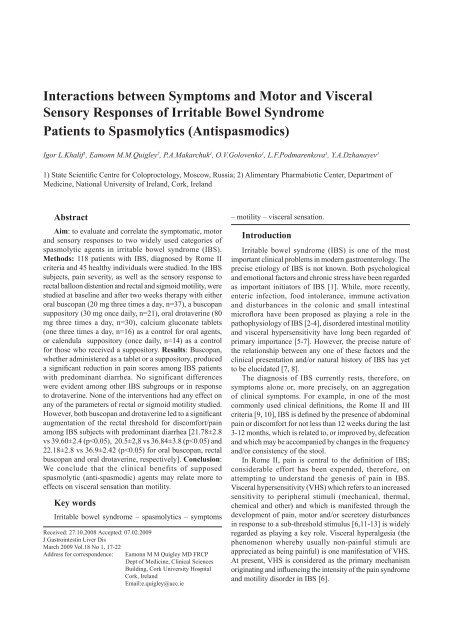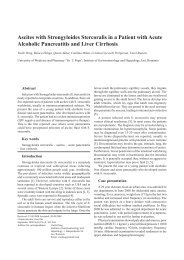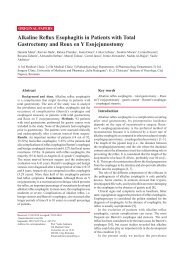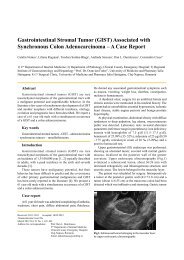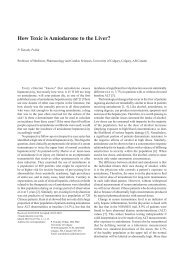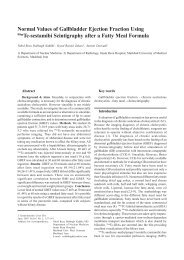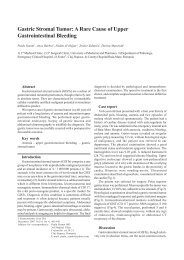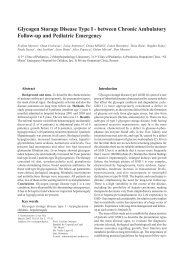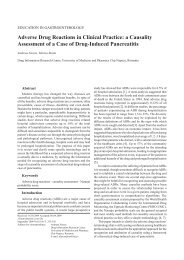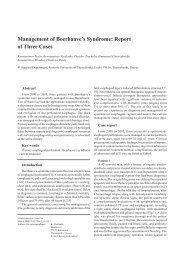download Full Article (PDF file) - Journal of Gastrointestinal and ...
download Full Article (PDF file) - Journal of Gastrointestinal and ...
download Full Article (PDF file) - Journal of Gastrointestinal and ...
You also want an ePaper? Increase the reach of your titles
YUMPU automatically turns print PDFs into web optimized ePapers that Google loves.
Interactions between Symptoms <strong>and</strong> Motor <strong>and</strong> Visceral<br />
Sensory Responses <strong>of</strong> Irritable Bowel Syndrome<br />
Patients to Spasmolytics (Antispasmodics)<br />
Igor L.Khalif 1 , Eamonn M.M.Quigley 2 , P.A.Makarchuk 1 , O.V.Golovenko 1 , L.F.Podmarenkova 1 , Y.A.Dzhanayev 1<br />
1) State Scientific Centre for Coloproctology, Moscow, Russia; 2) Alimentary Pharmabiotic Center, Department <strong>of</strong><br />
Medicine, National University <strong>of</strong> Irel<strong>and</strong>, Cork, Irel<strong>and</strong><br />
Abstract<br />
Aim: to evaluate <strong>and</strong> correlate the symptomatic, motor<br />
<strong>and</strong> sensory responses to two widely used categories <strong>of</strong><br />
spasmolytic agents in irritable bowel syndrome (IBS).<br />
Methods: 118 patients with IBS, diagnosed by Rome II<br />
criteria <strong>and</strong> 45 healthy individuals were studied. In the IBS<br />
subjects, pain severity, as well as the sensory response to<br />
rectal balloon distention <strong>and</strong> rectal <strong>and</strong> sigmoid motility, were<br />
studied at baseline <strong>and</strong> after two weeks therapy with either<br />
oral buscopan (20 mg three times a day, n=37), a buscopan<br />
suppository (30 mg once daily, n=21), oral drotaverine (80<br />
mg three times a day, n=30), calcium gluconate tablets<br />
(one three times a day, n=16) as a control for oral agents,<br />
or calendula suppository (once daily, n=14) as a control<br />
for those who received a suppository. Results: Buscopan,<br />
whether administered as a tablet or a suppository, produced<br />
a significant reduction in pain scores among IBS patients<br />
with predominant diarrhea. No significant differences<br />
were evident among other IBS subgroups or in response<br />
to drotaverine. None <strong>of</strong> the interventions had any effect on<br />
any <strong>of</strong> the parameters <strong>of</strong> rectal or sigmoid motility studied.<br />
However, both buscopan <strong>and</strong> drotaverine led to a significant<br />
augmentation <strong>of</strong> the rectal threshold for discomfort/pain<br />
among IBS subjects with predominant diarrhea [21.78±2.8<br />
vs 39.60±2.4 (p
18<br />
The pathogenesis <strong>of</strong> VHS in IBS is not completely<br />
understood. Neuromodulatory peptides, such as serotonin,<br />
are now thought to play a most important role [14]. As<br />
intraluminal pressure in the large intestine rises, the<br />
enterochromaffin cells which line the epithelium produce<br />
<strong>and</strong> release serotonin, which by activating 5-HT 3<br />
-<br />
receptors, located on afferent (sensory) neurons, results<br />
in the generation <strong>of</strong> ascending sensory impulses from the<br />
periphery [15]. In the cerebral cortex, these sensory impulses<br />
induce different sensations, including pain. Meanwhile, the<br />
activation <strong>of</strong> 5-HT 4<br />
<strong>and</strong> 5-HT 1<br />
receptors located on neurons<br />
in the submucosal nerve plexus, intensifies peristalsis <strong>and</strong><br />
promotes intestinal secretion [14, 16].<br />
Other factors may also play a role in the pathogenesis <strong>of</strong><br />
VHS, including an imbalance in the system which controls<br />
ascending pain impulses at the level <strong>of</strong> spinal interneurons,<br />
<strong>and</strong> a reduction in descending anti-nociceptive input from<br />
the cerebral cortex [15, 17].<br />
This focus on VHS has led to a search for agents that<br />
could decrease VHS <strong>and</strong> thus pain. Currently, the agents most<br />
widely used in an attempt to reduce pain in IBS are antispasmodics,<br />
also termed spasmolytics, directed at intestinal<br />
smooth muscle. In the past, it was assumed that these agents<br />
acted through an inhibition <strong>of</strong> muscle “spasm”; their effects<br />
on what is thought to be a fundamental abnormality in IBS,<br />
VHS, has not, as yet, been studied.<br />
The aim <strong>of</strong> this study was to examine, in a dynamic<br />
fashion, relationships between pain, motility <strong>and</strong> visceral<br />
sensation, among IBS patients being treated with myogenic<br />
spasmolytics.<br />
Methods<br />
Patient characteristics<br />
The study was carried out on 118 consecutive patients<br />
with IBS, diagnosed in accordance with Rome II criteria [9].<br />
The age <strong>of</strong> the patients was 33.8±10.4 years; 85 (67.4%)<br />
were females. In terms <strong>of</strong> IBS predominant symptom, 43<br />
had constipation, 25 diarrhea, <strong>and</strong> in 50 patients pain <strong>and</strong><br />
bloating dominated the clinical picture. None had consumed<br />
antispasmodic medications prior to study.<br />
The control group comprised 45 healthy individuals free<br />
<strong>of</strong> gastrointestinal symptoms. The age <strong>of</strong> the control subjects<br />
was 32.6± 6.2 years; 20 were male <strong>and</strong> 25 female.<br />
Method<br />
Pain intensity at baseline <strong>and</strong> following treatment was<br />
estimated with the aid <strong>of</strong> a visual analog scale. Patients were<br />
asked to mark their pain intensity along a 20 cm graduated<br />
line where 0 corresponded to an absence <strong>of</strong> pain <strong>and</strong> 20 to<br />
unbearable pain.<br />
Visceral sensation was assessed in both IBS patients<br />
<strong>and</strong> controls by assessing the response to balloon inflation.<br />
Following an overnight fast <strong>and</strong> the administration <strong>of</strong> a<br />
one liter cleansing enema on the previous evening, a latex<br />
balloon connected to a catheter syringe was introduced<br />
into the rectum <strong>and</strong> inflated in a step-wise fashion in 10 ml<br />
increments at 1 minute intervals.<br />
Khalif et al<br />
The subjective symptomatic response <strong>of</strong> the patient to<br />
balloon inflation was assessed throughout. The minimum<br />
pressure, at which discomfort or pain was experienced, was<br />
defined for each patient as their threshold for sensation.<br />
Colonic motility was assessed at baseline in all patients<br />
using the multiple balloon manometry technique. Prior to<br />
testing, rectal evacuation was achieved with an enema; all<br />
medications that could affect colorectal motility had been<br />
discontinued for at least two days. A multi-channel probe<br />
incorporating five 2 ml balloons arrayed at a distance <strong>of</strong><br />
5 cm from each other was then introduced into the colon<br />
under sigmoidoscopic guidance. During the examination<br />
the patient lay on their left side with their knees drawn up to<br />
the chest. Recordings commenced 15 to 20 minutes after the<br />
introduction <strong>of</strong> the probe <strong>and</strong> were continued for 2 hours.<br />
All data from sensory <strong>and</strong> motility studies was displayed<br />
on a monitor <strong>and</strong> subsequently analyzed using the Polygraf<br />
gastrointestinal motility recording system (Medtronic,<br />
USA-Denmark).<br />
Control data for the colonic motility studies was derived<br />
from prior studies <strong>of</strong> the large intestine <strong>of</strong> healthy volunteers<br />
at the State Scientific Centre <strong>of</strong> Coloproctology (Moscow,<br />
Russia) [18].<br />
Study protocol<br />
On completion <strong>of</strong> the baseline measurements, 96 <strong>of</strong><br />
the original 118 patients agreed to participate in the rest <strong>of</strong><br />
the protocol <strong>and</strong> were consecutively assigned (in a manner<br />
that ensured equal distribution <strong>of</strong> IBS subgroups to each<br />
therapeutic group) to one <strong>of</strong> five groups <strong>and</strong> received one <strong>of</strong><br />
the following medications over the next two weeks:<br />
1. Oral buscopan – 60 mg daily (20 mg three times a<br />
day) (n=37);<br />
2. Buscopan suppository, 30 mg once daily (n=21);<br />
3. Oral drotaverine – 240 mg per day (80 mg three times<br />
a day) (n=30);<br />
4. Calcium gluconate tablets (0.5g one three times a day)<br />
(n=16), as a control for oral agents;<br />
5. Calendula (Calendula Officinalis L., or marigold,<br />
a herbal preparation) suppository once daily (n=14), as a<br />
control for those who received a suppository.<br />
Given the differences in formulation <strong>and</strong> method <strong>of</strong><br />
administration <strong>of</strong> the various medications, subjects were<br />
not blinded to their therapeutic agent. Those performing the<br />
objective measurements (manometry <strong>and</strong> sensory testing) as<br />
well as those recording symptomatic responses were blinded<br />
to the patient’s therapy.<br />
All sensory <strong>and</strong> motility tests were repeated in each <strong>of</strong><br />
these groups at the end <strong>of</strong> the treatment period. As at baseline,<br />
all studies were performed in the morning on an empty<br />
stomach, the last dose <strong>of</strong> medication having been taken on<br />
the evening before.<br />
Data analysis<br />
Motor activity <strong>of</strong> the large bowel was represented<br />
by recognizable patterns <strong>of</strong> wave forms which could be<br />
classified as segmenting, peristaltic <strong>and</strong> propulsive. Their<br />
differentiation was based on amplitude, propagation <strong>and</strong>
Irritable bowel syndrome <strong>and</strong> spasmolytics 19<br />
temporal occurrence as well as the very specific features <strong>of</strong><br />
the propulsive waves. Segmenting contractions featured low<br />
amplitude waves <strong>and</strong> were non-propagating. Specific features<br />
<strong>of</strong> peristaltic waves included their distal propagation, high<br />
amplitude <strong>and</strong> intermediate duration. Propulsive waves were<br />
rare, related, perhaps to the prior cleansing <strong>of</strong> the rectum but<br />
were very distinctive being <strong>of</strong> high amplitude, long duration<br />
(approx 30 sec) <strong>and</strong> distinctly propagative. These waves<br />
correspond to the high amplitude propagating contractions<br />
or power contractions described by others.<br />
In evaluating motor activity, the following values were<br />
defined:<br />
a. The magnitude <strong>of</strong> the tone <strong>of</strong> intestinal wall, calculated<br />
using the formula Tone = 1/ A, where A is amplitude <strong>of</strong><br />
respiration waves, expressed in mmHg;<br />
b. The median amplitude <strong>and</strong> duration <strong>of</strong> individual<br />
waves <strong>of</strong> motor activity;<br />
c. Longitudinal relationships between wave forms (i.e.<br />
whether segmenting, peristaltic or propulsive);<br />
d. The index <strong>of</strong> motor activity calculated using the<br />
formula:<br />
Index = ∑ A x t / T , where A = amplitude <strong>of</strong> wave, t =<br />
duration <strong>of</strong> the wave, T = the duration <strong>of</strong> the period <strong>of</strong><br />
recording registering <strong>and</strong> ∑ = sum <strong>of</strong> A x t<br />
e. Timing <strong>and</strong> intensity <strong>of</strong> the 1 st <strong>and</strong> 2 nd phases <strong>of</strong> the<br />
gastro-colonic reflex.<br />
Statistics<br />
For comparisons pre- <strong>and</strong> post-treatment, within a given<br />
group Student’s t-test or Wilcoxon <strong>and</strong> Mann-Whitney U<br />
tests were used, for parametric <strong>and</strong> non-parametric data,<br />
respectively. Where multiple comparisons were performed,<br />
the Bonferroni correction was used.<br />
Results<br />
All 96 subjects who entered the r<strong>and</strong>omization phase<br />
completed the two-week study (Table 1); there were no<br />
drop-outs relating to adverse events or otherwise <strong>and</strong>,<br />
indeed, no side effects were reported in relation to any <strong>of</strong><br />
the therapies.<br />
1. Baseline symptoms <strong>and</strong> response to treatment<br />
(Table I)<br />
As expected, the highest pain scores were recorded at<br />
baseline by those IBS patients with predominant pain <strong>and</strong><br />
bloating. On the visual analog scale, the average intensity<br />
<strong>of</strong> pain at baseline was estimated by IBS patients with<br />
predominant pain <strong>and</strong> bloating at 13 (on a scale whose<br />
maximum was 20 points), by IBS patients with predominant<br />
diarrhea at 10 points <strong>and</strong> by IBS patients with predominant<br />
constipation at 8 points.<br />
Significant reductions in pain score were achieved<br />
only among IBS patients with predominant diarrhea <strong>and</strong> in<br />
response to either oral or per suppository buscopan.<br />
2. Rectal sensation<br />
a. Baseline studies<br />
In the control group, the threshold for the development<br />
<strong>of</strong> discomfort/pain was 43.6±3.2 mm Hg which corresponds<br />
closely to previous reports [6]. In the IBS patients, the<br />
threshold for the development <strong>of</strong> discomfort/pain was<br />
significantly lower at 24.08 mmHg. Differences in<br />
discomfort/pain threshold were also evident between the<br />
IBS subgroups, being significantly (p0.05<br />
32.61±5.08 35.4±2.6 p>0.05<br />
21.78±2.8 39.60±2.4 p
20<br />
sensitivity threshold reaching the normal value (p0.05<br />
22.18±2.8 36.9±2.42 p0.05<br />
31.06±4.18 31.58±.6 p>0.05<br />
25.48±2.66 30.8±2.33 p>0.05<br />
Following treatment with buscopan as a suppository<br />
(Table V), IBS patients with predominant pain <strong>and</strong> bloating<br />
showed an increase <strong>of</strong> their discomfort/pain sensitivity<br />
threshold to 33.96±4.6 (ns) <strong>and</strong> 23% reached normal values<br />
(≥40mm.Hg). The group with predominant constipation<br />
showed only a slight <strong>and</strong> non-significant increase <strong>of</strong> their<br />
discomfort/pain sensitivity threshold to 34.22±3.64mm.Hg.<br />
In the group <strong>of</strong> IBS patients with predominant diarrhea,<br />
a significant increase <strong>of</strong> the discomfort/pain sensitivity<br />
threshold was observed, to 36.84± 3.8 mm.Hg. However, a<br />
normal discomfort/pain threshold was not reached by any<br />
patient among these groups.<br />
No significant changes or even trends in discomfort/<br />
pain threshold were identified in any IBS group following<br />
treatment with the placebo calendula suppository (Table<br />
VI).<br />
p<br />
p<br />
Khalif et al<br />
Table V. Discomfort/pain thresholds in IBS patients in response<br />
to buscopan as a suppository<br />
Clinical types <strong>of</strong> IBS<br />
IBS with predominant pain<br />
<strong>and</strong> bloating (n=11)<br />
IBS with predominant<br />
constipation (n=6)<br />
IBS with predominant<br />
diarrhea (n=4)<br />
3. Colonic motility<br />
In the IBS patients, the balloon kymographic data<br />
revealed hypersegmentary hypokinesia in 67%, hypotonic<br />
hypokinesia was observed in 24% <strong>and</strong> antiperistaltic<br />
complexes in 9%. We did not identify any differences in<br />
motility parameters either between IBS subtypes or before<br />
<strong>and</strong> after treatment with any <strong>of</strong> the preparations tested<br />
(Tables VII, VIII).<br />
Discussion<br />
Discomfort/pain threshold (mmHg)<br />
Before<br />
treatment<br />
After<br />
treatment<br />
28.32±5.2 33.96±4.6 p>0.05<br />
31.63±4.08 34.22±3.64 p>0.05<br />
20.5±2.8 36.84±3.8 p0.05<br />
32.22±5.3 32.66±3.2 p>0.05<br />
28.14±3.0 28.10±3.24 p>0.05<br />
This placebo-controlled study investigated relationships<br />
between symptomatic, motility <strong>and</strong> visceral sensory effects<br />
<strong>of</strong> two pharmacological agents (buscopan <strong>and</strong> drotaverine)<br />
which have been developed <strong>and</strong> are used on the basis <strong>of</strong> their<br />
antispasmodic properties. Buscopan hydrochloride has been<br />
shown, in a large placebo-controlled study to relieve IBStype<br />
pain <strong>and</strong> is widely used for this indication world-wide<br />
[19] while drotaverine, a papaverine derivative, <strong>and</strong> related<br />
componds, such as alverine, have been widely used as a<br />
spasmolytic agent in obstetrics, urology <strong>and</strong> gastroenterology<br />
[20]. The main finding <strong>of</strong> this study was that while neither<br />
agent had any effect on motor parameters in the rectum <strong>and</strong><br />
sigmoid colon, the agent that had a symptomatic benefit,<br />
buscopan, exerted its principal physiological effects not<br />
on parameters <strong>of</strong> motor activity, but on visceral sensation.<br />
Indeed, indices <strong>of</strong> motor function <strong>of</strong> the large intestine<br />
changed very little following treatment; while a few instances<br />
<strong>of</strong> recovery <strong>of</strong> intraluminal pressure to normal values were<br />
observed, these patients remaining symptomatic. Therefore,<br />
balloon kymography, the methodology employed in this<br />
study, while producing interpretable recordings <strong>of</strong> colorectal<br />
motor activity, did not prove <strong>of</strong> value in predicting the likely<br />
efficacy <strong>of</strong> a given therapy.<br />
p<br />
p
Irritable bowel syndrome <strong>and</strong> spasmolytics 21<br />
Table VII. Rectal motility parameters in IBS patients<br />
Motility Parameters<br />
Motor Activity<br />
(as a % <strong>of</strong> total time)<br />
(normal: 75.6±4.7)<br />
Motor Quiescence<br />
(as a % <strong>of</strong> total time)<br />
(normal: 24.46±4.7)<br />
Intraluminal pressure<br />
(cm H 2<br />
O)<br />
(normal: 25-30)<br />
Motility index<br />
(normal: 8,5)<br />
Type <strong>of</strong> IBS Before After Before After Before After Before After<br />
IBS with predominant constipation (n= 36) 75.3±6.2 75.4±8.2 24.7±4.3 26.4±4.8 58.4±0.57 47.3±5.6 5.7±3.1 5.9±2.8<br />
IBS with predominant diarrhea (n= 21) 70.5±6.8 70.2±4.3 24.4±5.8 24.5±4.3 56.4±0.44 48.4±5.9 5.9±2.2 6.8±2.2<br />
IBS with predominant pain <strong>and</strong> bloating (n= 39) 75.4±5.2 72.6±2.3 26.8±4.4 22.±4.0 52.8±0.55 48.6±4.6 5.2±2.4 5.8±2.6<br />
Table VIII. Sigmoid motility parameters in IBS patients<br />
Motility parameters Time <strong>of</strong> activity (%)<br />
normal: (85.8±2.2)<br />
Time <strong>of</strong> rest (%)<br />
(normal: 14.2±2.2)<br />
Intraluminal pressure<br />
(cm H 2<br />
O)<br />
(normal: 30-40)<br />
Activity index<br />
normal: 12,5)<br />
Type <strong>of</strong> IBS Before After Before After Before After Before After<br />
IBS with predominant constipation (n= 36) 67.3±4.2 69.6±5.2 35.2±4.2 32.4±4.4 47.4±4.8 42.2±6.2 7.2±1.6 7.5±2.2<br />
IBS with predominant diarrhea (n= 21) 65.5±6.8 68.4±4.2 33.4±6.6 30.2±4.2 45.4±4.6 40.3±5.2 7.5±2.2 7.4±1.8<br />
IBS with predominant pain <strong>and</strong> bloating (n= 39) 64.4±4.6 68.3±4.2 36.6±6.4 32.3±6.8 48.2±4.6 40.8±5.6 7.5±1.8 7.4±2.8<br />
Visceral hypersensitivity testing, in contrast, proved more<br />
useful; increases in the threshold for pain coinciding with a<br />
decrease in the patients’ experience <strong>of</strong> pain as a symptom.<br />
Furthermore, it is worth noting that the lower the level<br />
<strong>of</strong> the pain threshold at baseline, the more pronounced the<br />
effect, which might explain the low effectiveness <strong>of</strong> the<br />
various preparations among IBS patients with predominant<br />
constipation. Indeed, the pathogenesis <strong>of</strong> VHS in different<br />
types <strong>of</strong> IBS may vary to some extent as may the impact <strong>of</strong><br />
various pharmacological agents.<br />
Values for visceral sensitivity are considerably influenced<br />
by the method employed. It appears that not only the<br />
material employed in the manufacture <strong>of</strong> the balloon, but<br />
also the technique <strong>of</strong> inflation can significantly influence<br />
the study outcome. Slow constant inflation results in<br />
accommodation <strong>of</strong> the rectum, while stepwise inflation does<br />
not <strong>and</strong> hypersensitivity has been observed far more <strong>of</strong>ten in<br />
studies employing step-wise inflation methods. Accordingly,<br />
the threshold for pain sensitivity with the more traditional<br />
method <strong>of</strong> slow continuous balloon inflation was significantly<br />
lower than with the use <strong>of</strong> the tracked step technique [21,<br />
22]. Indeed, Lembo et al could not differentiate between<br />
IBS subjects <strong>and</strong> controls when using the constant inflation<br />
technique [7]. Apart from methodological issues, it is also<br />
evident that variations in perception by individual patients,<br />
prior conditioning [23] <strong>and</strong> psychological factors will also<br />
influence the outcome <strong>of</strong> such tests <strong>and</strong> present considerable<br />
challenges in developing the ideal test for VHS as well<br />
as in underst<strong>and</strong>ing the pathogenesis <strong>of</strong> pain in IBS [12].<br />
Pending the development <strong>of</strong> the ideal technique, balloon<br />
inflation employing the step-wise technique remains the<br />
most accessible method for assessing VHS in clinical<br />
practice. However, it is noteworthy that the threshold for<br />
discomfort/sensation documented in this study is remarkably<br />
similar to that <strong>of</strong> Bouin et al, who reported, in their large<br />
series <strong>of</strong> IBS <strong>and</strong> control subjects that a cut <strong>of</strong>f threshold <strong>of</strong><br />
40 mmHg was highly sensitive (90.7%) <strong>and</strong> specific (71.8%)<br />
in differentiating IBS patients from healthy controls [6].<br />
We acknowledge the limitations <strong>of</strong> the study. It was<br />
not formally r<strong>and</strong>omized; however, the demographics <strong>of</strong><br />
the various groups illustrate that each was representative<br />
<strong>of</strong> the overall population <strong>and</strong> <strong>of</strong> IBS in the community.<br />
Furthermore, the investigators were blinded to the treatments<br />
<strong>and</strong> as results <strong>of</strong> objective tests from the bulk <strong>of</strong> the recorded<br />
data, this should have minimized the effects <strong>of</strong> a failure to<br />
r<strong>and</strong>omize. It is also possible that drug effects could have<br />
unblinded the patients; we feel that this is unlikely as the one<br />
drug that had an effect on symptoms, buscopan, is poorly<br />
bio-available when taken orally with associated plasma<br />
levels being below levels <strong>of</strong> detection [24].<br />
In conclusion, in this study, while we observed the<br />
presence <strong>of</strong> visceral hypersensitivity in all IBS patients<br />
studied, the lowest threshold for pain sensitivity was<br />
noted among those with predominant diarrhea. Among the<br />
therapeutic agents studied, the most pronounced effect on the<br />
pain sensitivity threshold was reached with buscopan when<br />
given orally, <strong>and</strong> had its greatest impact among those with<br />
predominant diarrhea. In contrast, none <strong>of</strong> the therapies had<br />
a major effect on any <strong>of</strong> the parameters <strong>of</strong> colorectal motility<br />
studied. We propose, therefore, that visceral hypersensitivity<br />
<strong>and</strong> not motor dysfunction may be a more appropriate<br />
target for assessing the impact <strong>of</strong> proposed antispasmodics/<br />
spasmolytics in IBS.<br />
Conflicts <strong>of</strong> interest<br />
Nothing to declare.<br />
References<br />
1. Drossman DA, Creed FH, Olden KW, Svedlund J, Toner BB,<br />
Whitehead WE. Psychosocial aspects <strong>of</strong> the functional gastrointestinal<br />
disorders. Gut 1999; 45 (Suppl 2): II25–30.<br />
2. McKendrick MW, Read NW. Irritable bowel syndrome-post<br />
salmonella infection. J Infect 1994; 29: 1–3.<br />
3. Neal KR, Hebden J, Spiller RC. Prevalence <strong>of</strong> gastrointestinal<br />
symptoms six months after bacterial gastroenteritis <strong>and</strong> risk factors
22<br />
for development <strong>of</strong> the irritable bowel syndrome: postal survey <strong>of</strong><br />
patients. BMJ 1997; 314: 779–782.<br />
4. Quigley EM. Irritable bowel syndrome <strong>and</strong> inflammatory bowel<br />
disease: interrelated diseases? Chin J Dig Dis 2005; 6: 122-132.<br />
5. Quigley EM. Disturbances <strong>of</strong> motility <strong>and</strong> visceral hypersensitivity<br />
in irritable bowel syndrome: biological markers or epiphenomenon.<br />
Gastroenterol Clin North Am 2005;34:221-233.<br />
6. Bouin M, Plourde V, Boivin M, et al. Rectal distention testing in<br />
patients with irritable bowel syndrome: sensitivity, specificity, <strong>and</strong><br />
predictive values <strong>of</strong> pain sensory thresholds. Gastroenterology 2002;<br />
122: 1771-1777.<br />
7. Lembo T, Munakata J, Mertz H, et al. Evidence for the<br />
hypersensitivity <strong>of</strong> lumbar splanchnic afferents in irritable bowel<br />
syndrome. Gastroenterology 1994; 107: 1686–1696.<br />
8. Sheptulin AA. Modern notions on irritable bowel syndrome. Russian<br />
Med Magazine 2001; 9: 538-542.<br />
9. Thompson WG, Longstreth GF, Drossman D A, Heaton KW, Irvine<br />
EJ, Muller-Lissner SA. Functional bowel disorders <strong>and</strong> functional<br />
abdominal pain.. Gut 1999; 45 (Suppl 2): II43-47.<br />
10. Longstreth GF, Thompson WG, Chey WD, Houghton LA, Mearin<br />
F, Spiller RC. Functional bowel disorders. Gastroenterology 2006;<br />
130: 1480-1491.<br />
11. Whitehead WE, Holtkotter B, Enck P, et al. Tolerance for rectosigmoid<br />
distension in irritable bowel syndrome. Gastroenterology 1990; 98:<br />
1187–1192.<br />
12. Mertz H, Nalib<strong>of</strong>f B, Munakata J, Niazi N, Mayer EA. Altered rectal<br />
perception is a biological marker <strong>of</strong> patients with irritable bowel<br />
syndrome. Gastroenterology 1995; 109: 40-52.<br />
13. Whitehead WE, Crowell MD, David<strong>of</strong>f AL, Palsson OS, Schuster<br />
MM. Pain from rectal distension in women with irritable bowel<br />
syndrome. Dig Dis Sci 1997; 42: 796–804.<br />
14. Gershon MD. Importance <strong>of</strong> serotonergic mechanisms in<br />
Khalif et al<br />
gastrointestinal motility <strong>and</strong> sensation. In: Camilleri M, Spiller RC,<br />
eds. Irritable bowel syndrome; diagnosis <strong>and</strong> treatment. Philadelphia,<br />
WB Saunders Co. 2002, pp.95-116.<br />
15. Mertz H. Altered CNS processing <strong>of</strong> visceral pain in IBS. In:<br />
Camilleri M <strong>and</strong> Spiller RC eds. Irritable bowel syndrome; diagnosis<br />
<strong>and</strong> treatment. Philadelphia WB Saunders Co 2002, pp.55-68.<br />
16. Bharucha AE, Camilleri M, Haydock S, et al. Effects <strong>of</strong> a serotonin<br />
5-HT(4) receptor antagonist SB-207266 on gastrointestinal motor<br />
<strong>and</strong> sensory function in humans. Gut 2000; 47: 667-674.<br />
17. Baranskaya EK. Abdominal pain: clinical approach to a patient <strong>and</strong><br />
algorithm <strong>of</strong> the treatment. Pharmateca 2005; 14: 49-57.<br />
18. Podmarenkova LF. Pathways <strong>of</strong> development <strong>of</strong> motor <strong>and</strong><br />
cumulative functions <strong>of</strong> the rectum in normal <strong>and</strong> when the sphincter<br />
apparatus is disturbed. PhD Thesis, University <strong>of</strong> Moscow, 2000.<br />
19. Mueller-Lissner S, Tytgat GN, et al. Placebo- <strong>and</strong> paracetamolcontrolled<br />
study on the efficacy <strong>and</strong> tolerability <strong>of</strong> hyoscine<br />
butylbromide in the treatment <strong>of</strong> patients with recurrent crampy<br />
abdominal pain. Aliment Pharmacol Ther 2006; 23: 1741-1748.<br />
20. Gupta B, Nellore V, Mittal S. Drotaverine hydrochloride versus<br />
hyoscine-N-butylbromide in augmentation <strong>of</strong> labor. Int J Gynaecol<br />
Obstet 2008; 100: 244-247.<br />
21. Nalib<strong>of</strong>f BD, Munakata J, <strong>Full</strong>erton S, et al. Evidence for two distinct<br />
perceptual alterations in irritable bowel syndrome. Gut 1997; 41:<br />
505-512.<br />
22. Lembo T, Nalib<strong>of</strong>f B, Munakata J, et al. Symptoms <strong>and</strong> visceral<br />
perception in patients with pain-predominant irritable bowel<br />
syndrome. Am J Gastroenterol 1999; 94: 1320–1326.<br />
23. Delvaux М. Do we need to perform rectal distention tests to diagnose<br />
IBS in clinical practice? Gastroenterology 2002; 122: 2075-2078.<br />
24. Tytgat GN. Hyoscine butylbromide: a review <strong>of</strong> its use in the<br />
treatment <strong>of</strong> abdominal cramping <strong>and</strong> pain. Drugs 2007; 67: 1343-<br />
1357.


